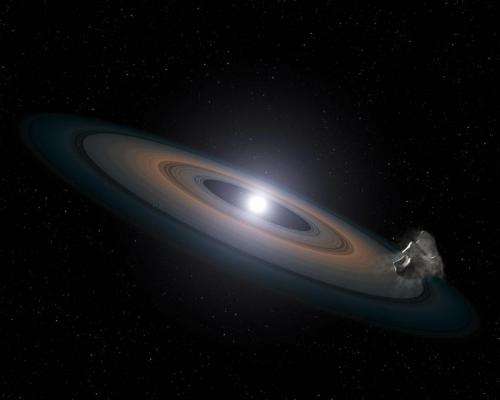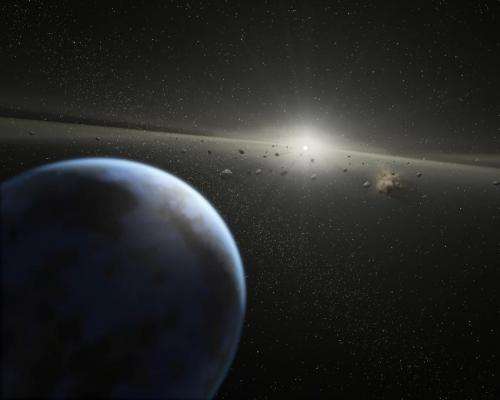Scientists solve riddle of celestial archaeology

A decades old space mystery has been solved by an international team of astronomers led by Professor Martin Barstow of the University of Leicester and President-elect of the Royal Astronomical Society.
Scientists from the University of Leicester and University of Arizona investigated hot, young, white dwarfs—the super-dense remains of Sun-like stars that ran out of fuel and collapsed to about the size of the Earth. Their research is featured in MNRAS- the Monthly Notices of the Royal Astronomical Society, published by Oxford University Press.
It has been known that many hot white dwarfs atmospheres, essentially of pure hydrogen or pure helium, are contaminated by other elements – like carbon, silicon and iron. What was not known, however, was the origins of these elements, known in astronomical terms as metals.
"The precise origin of the metals has remained a mystery and extreme differences in their abundance between stars could not be explained," said Professor Barstow, a Pro-Vice-Chancellor at the University of Leicester whose research was assisted by his daughter Jo, a co-author of the paper, during a summer work placement in Leicester. She has now gone on to be an astronomer working in Oxford - on extra-solar planets.
"It was believed that this material was "levitated" by the intense radiation from deeper layers in the star," said Professor Barstow.
Now the researchers have discovered that many of the stars show signs of contamination by rocky material, the left overs from a planetary system.

The researchers surveyed 89 white dwarfs, using the Far Ultraviolet Spectroscopic Explorer to obtain their spectra (dispersing the light by colour) in which the "fingerprints" of carbon, silicon, phosphorous and sulphur can be seen, when these elements are present in the atmosphere.
"We found that in stars with polluted atmospheres the ratio of silicon to carbon matched that seen in rocky material, much higher than found in stars or interstellar gas.
"The new work indicates that at around a one-third of all hot white dwarfs are contaminated in this way, with the debris most likely in the form of rocky minor planet analogues. This implies that a similar proportion of stars like our Sun, as well as stars that are a little more massive like Vega and Fomalhaut, build systems containing terrestrial planets. This work is a form of celestial archaeology where we are studying the 'ruins' of rocky planets and/or their building blocks, following the demise of the main star.
"The mystery of the composition of these stars is a problem we have been trying to solve for more than 20 years. It is exciting to realise that they are swallowing up the left overs from planetary systems, perhaps like our own, with the prospect that more detailed follow-up work will be able to tell us about the composition of rocky planets orbiting other stars", said Professor Barstow.
The study also points to the ultimate fate of the Earth billions of years from now- ending up as a contamination within the white dwarf Sun.
More information: The new work appears in "Evidence for an external origin of heavy elements in hot DA white dwarfs", M. A. Barstow, J. K. Barstow, S. L. Casewell, J. B. Holberg and I. Hubeny, Monthly Notices of the Royal Astronomical Society, Oxford University Press, in press. mnras.oxfordjournals.org/looku … 10.1093/mnras/stu216
Journal information: Monthly Notices of the Royal Astronomical Society
Provided by University of Leicester





















